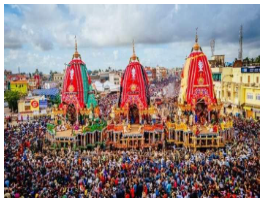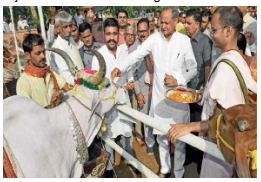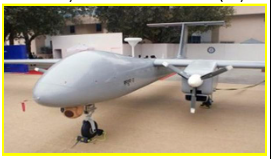|
Art and Culture
Rath Yatra in Puri starts

|
As the Rath Yatra starts, over 150 labourers, carpenters, artists, painters, etc., have been working for two months to complete these chariots.
- Nearly 15 lakh devotees from across the globe are expected to arrive for the annual event.
About the event:
- Location: RathaJatra, the Festival of Chariots of Lord Jagannatha is celebrated every year at Puri, the temple town in Orissa, on the east coast of India.
- Deities: The presiding deities of the main temple, Sri Mandira, Lord Jagannatha, Lord Balabhadra and Goddess Subhadra, with the celestial wheel Sudarshana are taken out from the temple on their respective chariots.
- Features: The huge, colourfully decorated chariots are drawn by hundreds and thousands of devotees on the badadanda, the grand avenue to the Gundicha temple, some two miles away to the North.
- After a stay for seven days, the deities return to their abode in Srimandira.
- The description of the chariot has been explained in the Kathopanishada, SkandaPurana, Brahma Purana, PadmaPurana, and KapilaSamhita, etc.
- Other names: The festival is also known as Gundicha Jatra, Ghosa Jatra, Navadina Jatra, Dasavatara Jatra and by a variety of other names.
|
|
History
Mesolithic-era rock paintings in Guntur

|
A Mesolithic period rock painting depicting a person tilling a piece of land has been found in Orvakallu village in Guntur district, Andhra Pradesh.
About:
- The paintings were made with “natural white kaolin and red ochre pigments”.
- Ochre is a pigment composed of clay, sand, and ferric oxide.
- Kaolinite is a soft, earthy, and usually white mineral produced by the chemical weathering of aluminium silicate minerals like feldspar.
|
- However, some of the sketches and outlines are still intact for the visitors.
- One of the paintings depicted a man catching wild goat with his left hand while wielding a hook-like implement to control it.
- Another showed two couple standing with their hands rose while a child stood behind them.
Mesolithic era:
- It was the transitional phase between the Palaeolithic and the Neolithic Ages. On the basis of archaeological discoveries, the beginning of the Mesolithic Age in Indian subcontinent is dated to around 10,000 BC.
- This period witnessed the rise in temperature, as a result of which the climate became warm.
- These changes further resulted in melting of ice of the earlier period and brought about changes in flora and fauna.
- Though man was still in hunting-gathering stage, he now started fishing and some domestication of animals.
- The main tools they used are called the microliths or small stone tools.
- The Rock paintings found at Bhimbetka (near Bhopal) belonging to the period indicate the artistic taste of the people.
|
|
Polity and Governance
Rajasthan's aid to boost religious tourism

|
The Rajasthan government has sanctioned Rs 13.48 crore to promote religious tourism in the Nagaur, Jaisalmer and Alwar regions of the state.
About the initiative:
- Rs 3.1 crore has been sanctioned for Butati in Nagaur district,
- Rs 1.65 crore for Ghatveshwar Mahadev Temple,
- Rs 1.61 crore for Harmal Das Ji Maharaj Temple and
- Rs 1.36 crore for improving facilities at Dargah Hazrat Samman Badi Khatu.
- Besides, an aid of Rs 4.24 crore has been sanctioned for the development of Mataji Mandir and Ganga Mata Mandir, Talvriksha in Alwar's Bansur Fort.
|
|
Science and Technology
INS Kirpan

|
India gifted the indigenously-built in-service missile corvette INS Kirpan to Vietnam to enhance that country’s naval capabilities.
About:
- INS Kirpan is a Khukri class missile corvette displacing 1,350 tonnes and was commissioned into the Navy on January 12, 1991.
- It has a displacement of close to 1,400 tonnes, a length of 91 metres, a beam of 11 metres, and is capable of speed in excess of 25 knots.
- The ship is fitted with a medium range gun, 30 mm close range guns, chaff launchers, and surface to surface missiles, enabling it to perform a wide variety of roles, including coastal and offshore patrol, coastal security, surface warfare, anti-piracy, and Humanitarian Assistance and Disaster Relief (HADR) operations.
|
|
Science and Technology
TAPAS (Tactical Airborne Platform for Aerial Surveillance) Unmanned Aerial Vehicle (UV)

|
In a remarkable feat, the Indian Navy and the Defence Research and Development Organisation (DRDO) successfully carried out the transfer of command and control capabilities of TAPAS Unmanned Aerial Vehicle (UAV).
About:
- The Tapas UAV, developed by DRDO, is a Medium Altitude Long Endurance (MALE) unmanned aerial vehicle.
- The vehicle, which was publicly showcased during its first flight at Aero India 2023 in Bengaluru earlier this year, has a range of more than 18 hours and can operate at altitudes of up to 28,000 feet.
- It was developed in response to the ISTAR (Intelligence, Surveillance, Target Acquisition, Tracking, and Reconnaissance) requirements of the tri-services.
|









